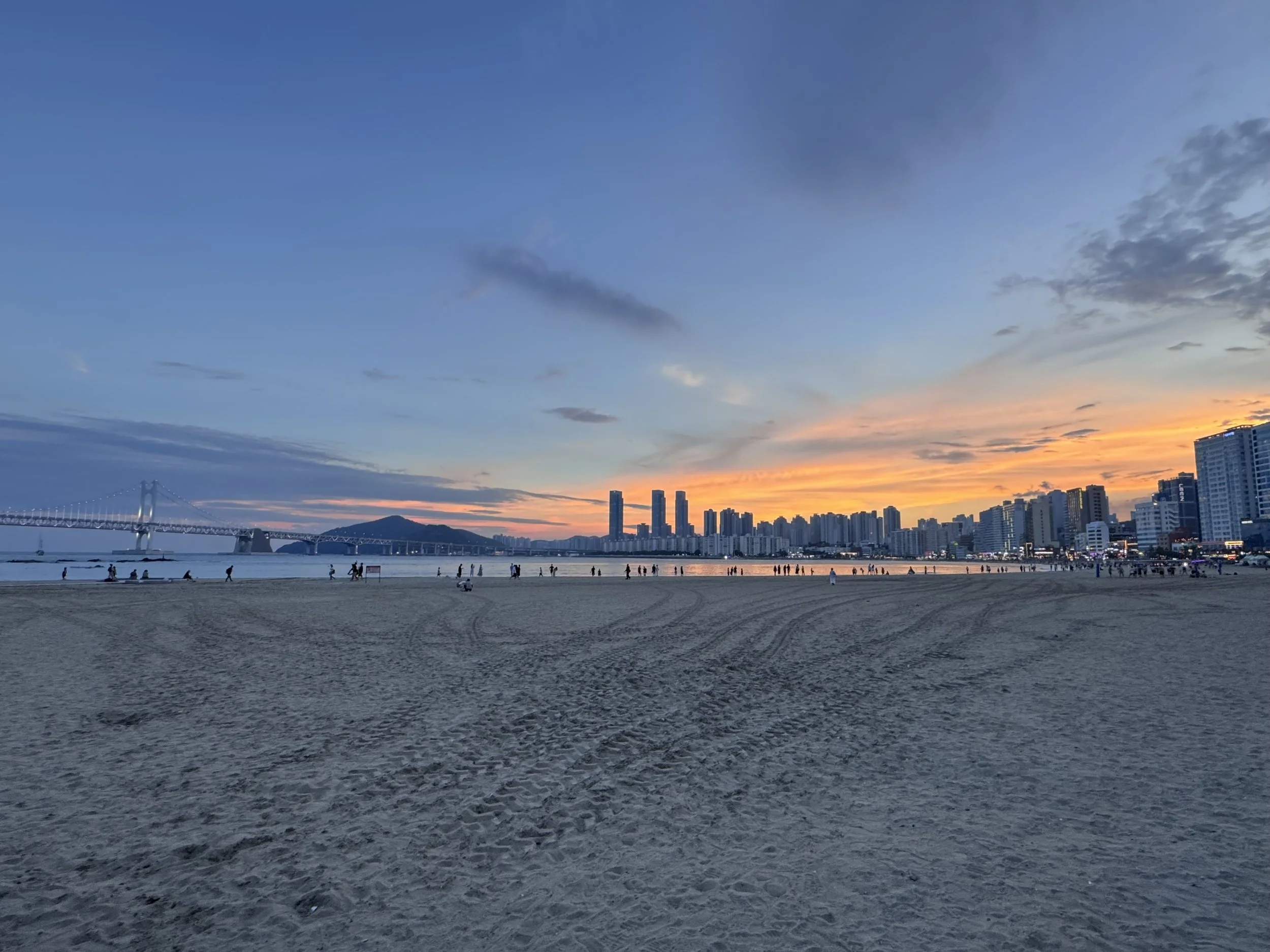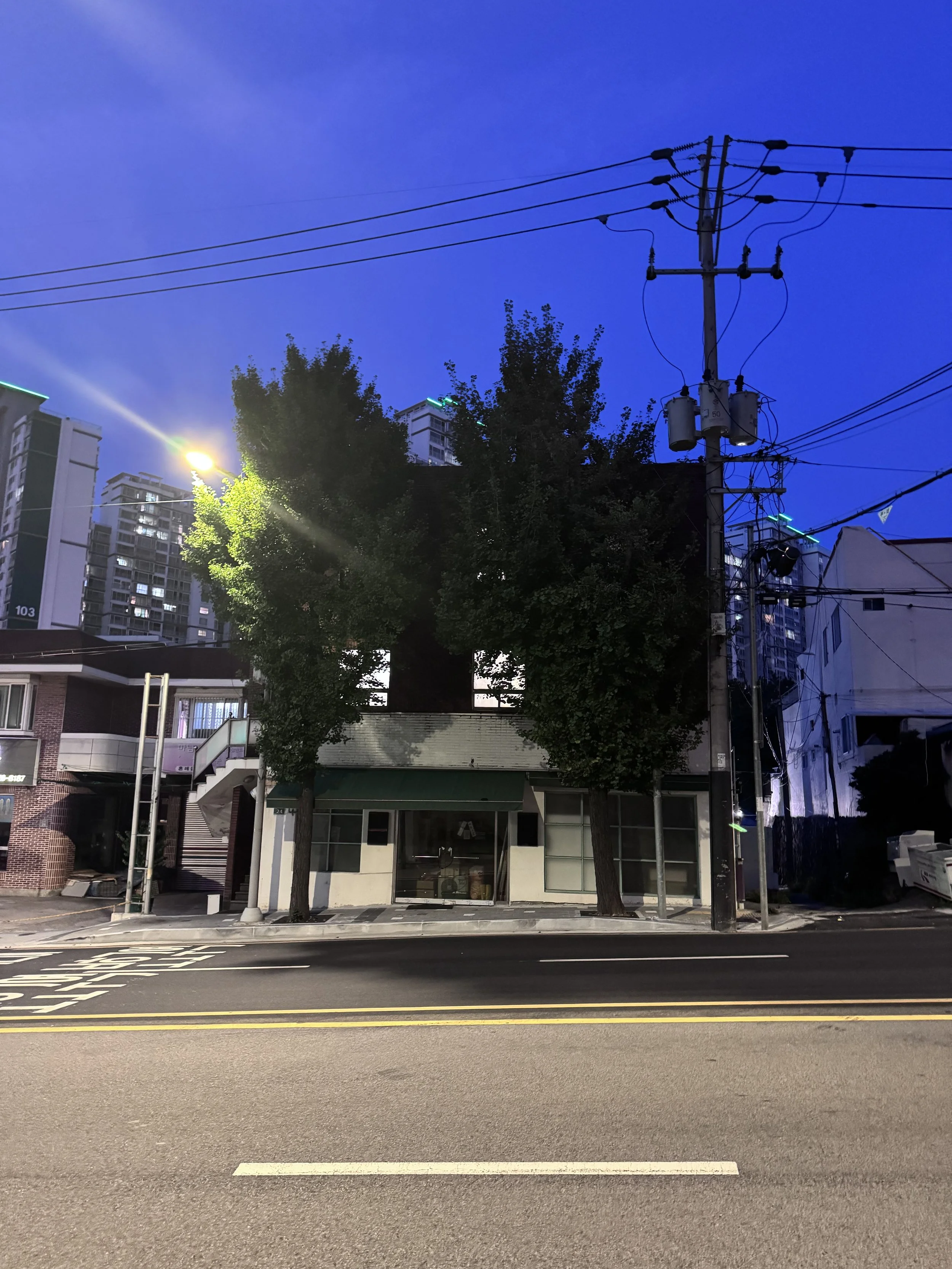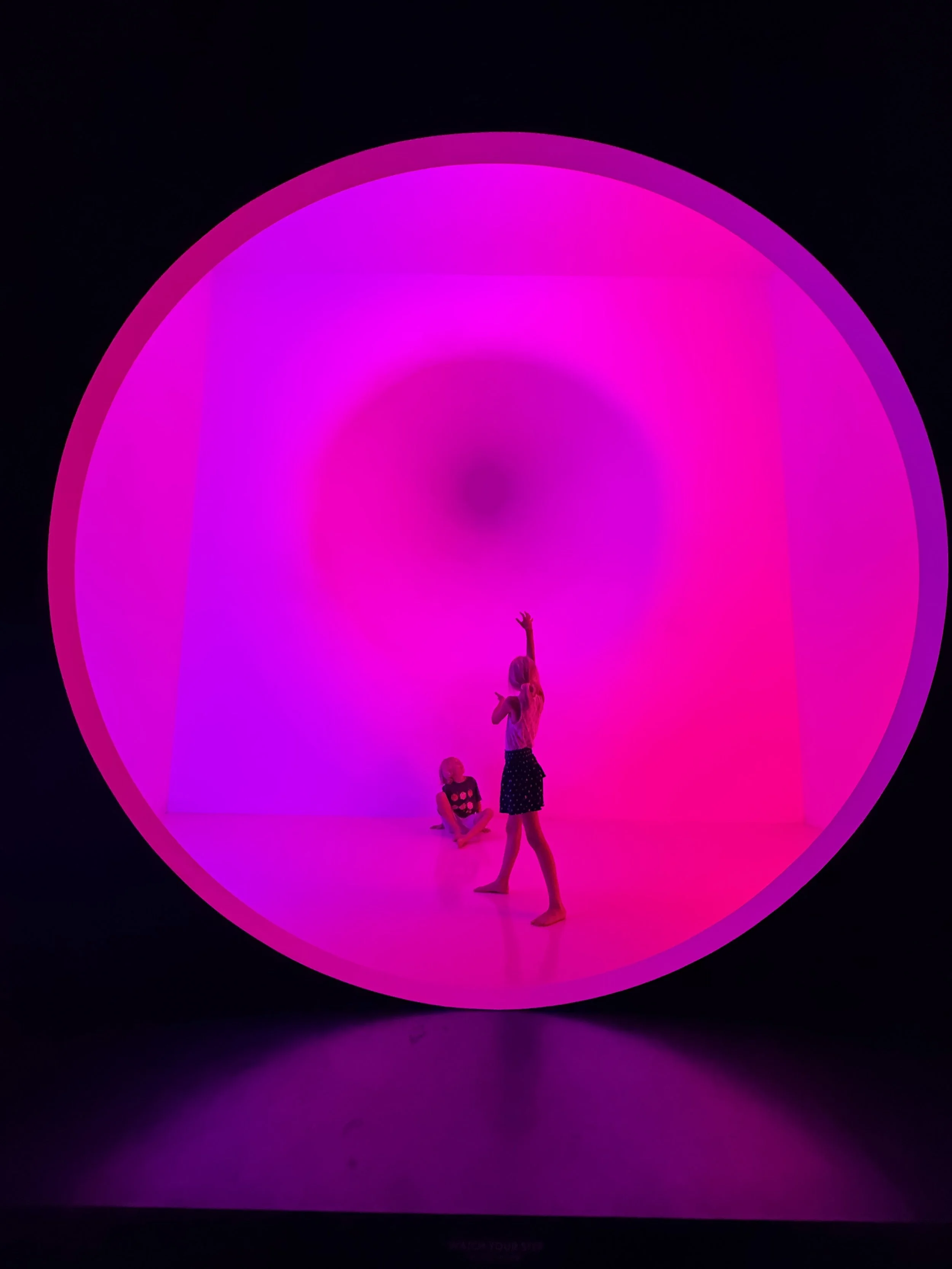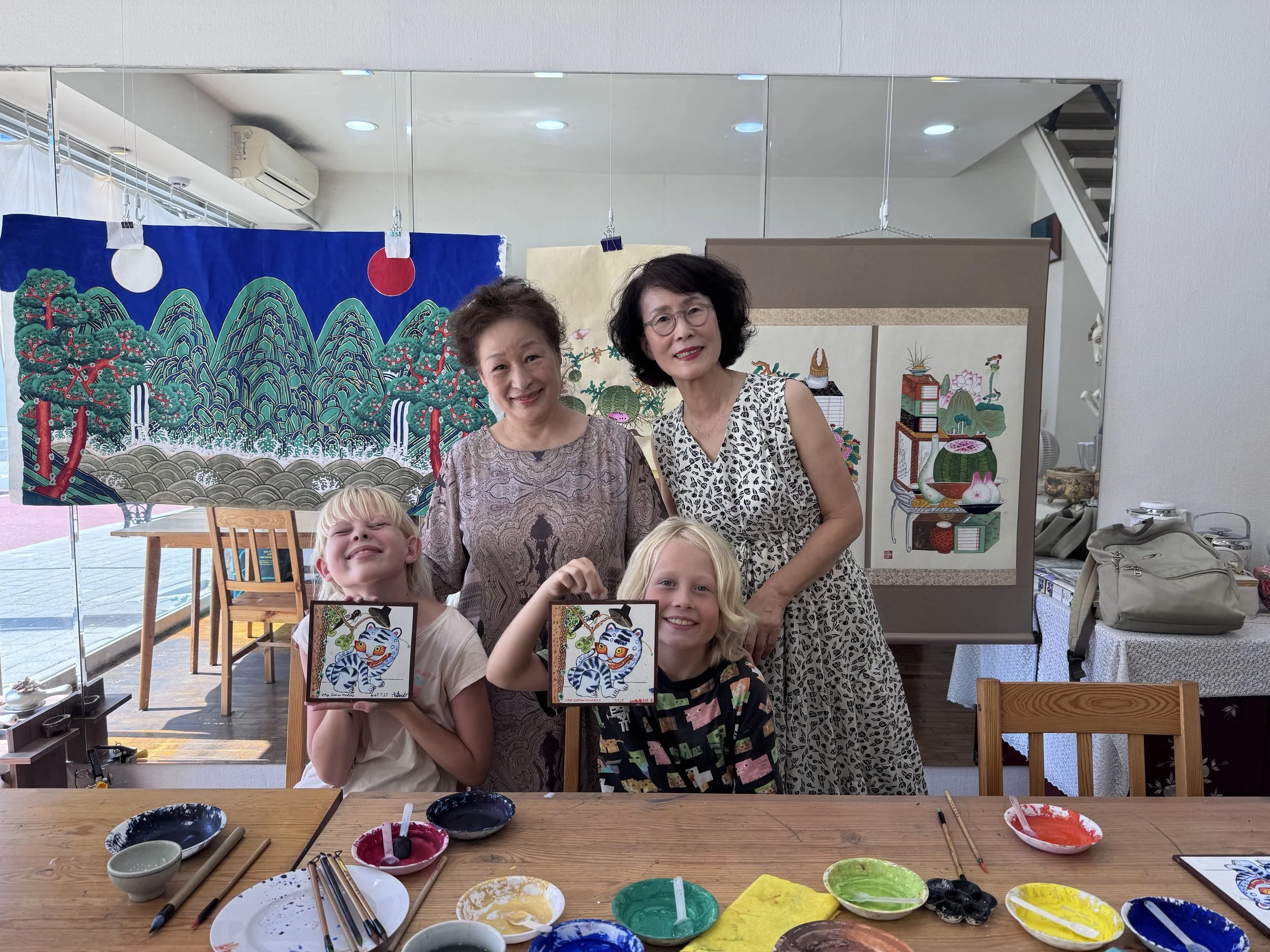Our days in Busan
I already wrote about how our first weeks in South Korea affected us, but I also want to share what it was like to be in Busan. This city became one of the places we could definitely imagine returning to someday. It has everything: vibrant city life and beaches side by side, colorful neighborhoods, mountains rising dramatically behind the skyline, and a sense of energy that never really slows down.
For us, Busan also turned into a cultural playground. We tried our hand at traditional Korean painting, stumbled into a live K-pop dance competition in the street, wandered through the Arte Museum, listened to jazz drifting out of cafés, and stood with open mouths at a light show and fireworks over the iconic Gwangan Bridge (Gwangandaegyo), the city’s most famous landmark stretching across the bay.
Beautiful sunset over the city
A little history
Busan has always been South Korea’s gateway to the world. Its port is the busiest in the country and among the largest in the world. Historically, Busan was one of the only ports open to Japanese and Western trade during Korea’s long period of isolation in the 19th century. During the Korean War, it became the temporary capital of South Korea and a place of refuge for millions of displaced people. Even today, you feel this mix of resilience, movement, and openness — a city shaped by both the sea and its history.
Sinhaeundae
We first stayed in Sinhaeundae, a quieter area outside the center. If we ever come back, I think this is where we’d choose again. Our apartment block there felt like such a luxury after China: several bedrooms, multiple bathrooms, a kitchen, living room, washing machine, and even a balcony! From here, we were close to nature, with space to breathe, and it felt more local and calm. On clear days, we could look out across the water toward Japan — and we learned there are ferries that can get you there in just about an hour.
It was the perfect retreat after our intense month in China. Yes, Busan has skyscrapers that climb even higher than the surrounding mountains, but what amazed us most was not the buildings — it was the mountains themselves, and the ocean, always present and alive.
Our first Airbnb, near Gwangalli Beach
After four days we moved into the city itself, into our very first Airbnb. We were greeted by the sweetest woman and her father, who welcomed us into their narrow brick house with so much warmth. The downstairs had once been a small shop, and our home was upstairs, reached by a steep staircase along the wall.
Inside it was decorated with curiosities everywhere, full of character and charm. She had prepared tea, snacks, flowers, and music playing when we arrived. It instantly felt like home, and for a full week we could settle in, breathe, and live our new rhythm.
Our home is a little shy, and tries to hide behind the trees.
Finding a school rhythm
Our daily routine has slowly started to form. Bjarne works three days a week, and those are also our school days. We’ve found the best way is to start early and be done by noon — because the beach (and adventure) calls loudly after that!
Still, it’s not always easy. Sometimes the “school day” is mostly about keeping balance, encouraging the kids enough to do even half an hour of math. Astrid and Hannes are both practicing multiplication tables, reading, and writing. But being mother, father, siblings, classmates, and teachers all at once is a challenge.
I have gained so much respect for their teachers back home in Hurdal. I try to remind myself that everything is learning — even when lessons take the form of big feelings, rebalancing, or learning to respect each other’s time. That is important education too.
One of our school days where spent at the Arte Museum. So incredibly cool.
The painting studio
One day, while grocery shopping, we passed a small workshop with the door open. Inside, a woman was painting, surrounded by delicate traditional Korean artworks. Curious, I stopped. Then Astrid came in, then Bjarne and Hannes, and suddenly the whole family was inside, trying to communicate in a mix of gestures, English, and a little Korean.
The artist and teacher, In-Yong Kim, had recently retired from her office career to finally dedicate herself fully to traditional Korean art. She welcomed us in, showed us her two-story workshop, and before we left she invited us to come back and paint.
A week later we returned, right on time at 10 a.m. She welcomed us with green tea, smiles, and prepared illustrations for the children — Derpy the tiger from K-pop Demon Hunters.
In K-pop Demon Hunters, the Korean tiger known as Derpy is a supernatural feline inspired by traditional Korean folk art, especially the Hojakdo paintings that pair a tiger with a magpie. With his blue-striped fur, tusk-like teeth, and goofy, unfocused eyes, Derpy serves as both comic relief and a cultural symbol. This tiger and the magpie is rooted in Korean mythology where tigers embody courage and protective power, he bridges the film’s modern fantasy and ancient symbols of strength and spirit.
In-Yong had set out brushes, pigments, and hanji paper for the children. In Korean painting, mineral and plant pigments are ground into fine powder, mixed with water, and carefully applied to hanji, a strong mulberry-bark paper that can last centuries.
She had also invited a close friend, a former Red Cross worker who had even visited Norway, and spoke enough English for us to share stories and laughter. For two hours Astrid and Hannes painted under In-Yong’s guidance, and with her encouragement they each completed their own tiger painting. Bjarne ran out to buy flowers for her as thanks, and our goodbye was warm and heartfelt. This is exactly the kind of encounter we long for: stepping behind the tourist façade and truly meeting people.
Our great teachers for the day with happy students and beautiful paintings
Everyday life in Busan
Life also became about small adjustments and self-care. Breakfasts were upgraded when we finally bought a blender. Bread with fiber is hard to find, and dairy doesn’t always agree with me, so now our mornings are full of fruit smoothies and vitamins. Yummy! We’ve also started taking turns going for early walks before the day begins.
Big emotions are part of traveling together as a family, and we are still very much in the “birth process” of this 10-month journey. We’re stretched in all directions, sometimes uncomfortably, but in a way that feels alive. Growth is rarely painless, but it is always meaningful.
Busan has taught us a lot about balance: caring for ourselves, enjoying the beauty around us, and saying yes to unexpected doors that open.
Next stop: Seoul, and we’re excited to see what awaits us there.




